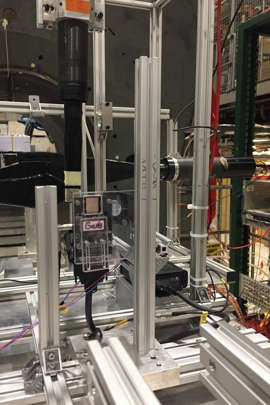
GaAs detector with trigger counters and other detectors designed for the independent identification of electrons and pions
The research group of the Department of Elementary Particle Physics, INPhT, NRNU MEPhI, has begun testing a prototype of a pixel transition radiation (PI) detector using particle beams from the SPS accelerator at CERN (European Organization for Nuclear Research). This is reported by the MEPhI website.
The prototype of the detector is based on a gallium arsenide (GaAs) crystal coupled with an integrated circuit for reading the TimePix3 signal, the pixel size of which is 55×55 μm2. Such a detector combines the capabilities of precision measurements of the coordinates of particles with a high detection efficiency of gamma quanta in the X-ray range. Experimental data were collected in the course of test tests of the detector's operation using beams of various types of particles (electrons, pions, and muons).
The purpose of testing a prototype detector on a particle beam was to directly study the properties of transition radiation and related effects. In particular, the possibility of using the interference effects of transition radiation in radiators consisting of organic films to increase the angle of flight of the PI and the particle was studied. The use of this effect will ensure the suppression of the incorrect identification of a pion as an electron by a factor of 100-1000 while maintaining the efficiency of registration of electrons at a level of more than 95%.
Transition radiation detectors make it possible to separate particles of different types in the energy range inaccessible to other non-invasive (i.e., practically not changing the state of a passing particle) identification methods. An increase in the efficiency of such detectors, in combination with the advantages of a precision track detector, expands the capabilities of the technique and opens up even more prospects for creating a new type of physics apparatus for future experiments.
The preparation of the test bench, GaAs-based detector, PI radiators, and other important parts of the experiment was carried out during June and July. At the end of July, data collection began. The staff of the department organized shift shifts for round-the-clock work on the beam. Students and postgraduates of the department also took part in the research work.
Read also:
A method for drug delivery to the retina has been developed
The buried Finnish warrior turned out to be “neither a woman, nor a man”
Module “Science” docked with the ISS
Results of the 62nd International Mathematical Olympiad
President of the Faculty of Journalism of Moscow State University Yasen Zasursky dies

